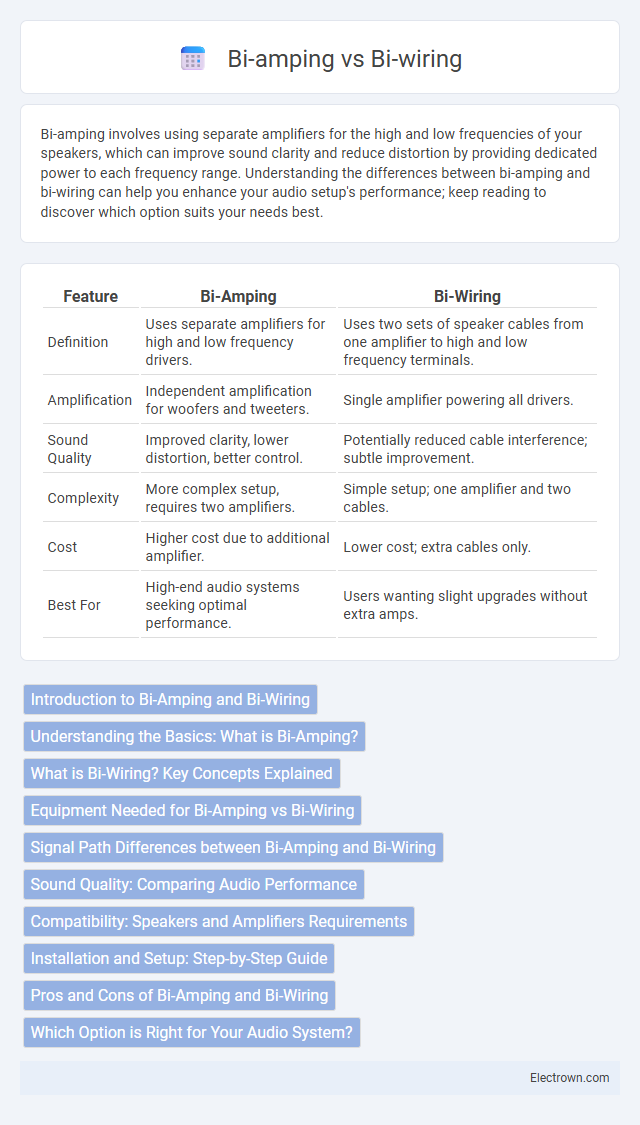Bi-amping involves using separate amplifiers for the high and low frequencies of your speakers, which can improve sound clarity and reduce distortion by providing dedicated power to each frequency range. Understanding the differences between bi-amping and bi-wiring can help you enhance your audio setup's performance; keep reading to discover which option suits your needs best.
Table of Comparison
| Feature | Bi-Amping | Bi-Wiring |
|---|---|---|
| Definition | Uses separate amplifiers for high and low frequency drivers. | Uses two sets of speaker cables from one amplifier to high and low frequency terminals. |
| Amplification | Independent amplification for woofers and tweeters. | Single amplifier powering all drivers. |
| Sound Quality | Improved clarity, lower distortion, better control. | Potentially reduced cable interference; subtle improvement. |
| Complexity | More complex setup, requires two amplifiers. | Simple setup; one amplifier and two cables. |
| Cost | Higher cost due to additional amplifier. | Lower cost; extra cables only. |
| Best For | High-end audio systems seeking optimal performance. | Users wanting slight upgrades without extra amps. |
Introduction to Bi-Amping and Bi-Wiring
Bi-amping involves using separate amplifiers for the low-frequency and high-frequency drivers in a speaker, enhancing power delivery and reducing distortion for improved sound clarity. Bi-wiring uses two sets of speaker cables from a single amplifier to the speaker's low and high-frequency inputs, potentially reducing interference and improving signal accuracy. Both techniques aim to optimize audio performance but achieve this through different approaches to amplifier usage and cable configuration.
Understanding the Basics: What is Bi-Amping?
Bi-amping involves using two separate amplifiers to independently power the high and low-frequency drivers of a speaker, improving sound clarity and reducing distortion by allocating dedicated power to each frequency range. This method requires a speaker system designed with separate inputs or bi-amp capable crossovers to properly manage signal distribution. Bi-amping enhances audio performance by providing stronger, more precise control over the speaker's components compared to bi-wiring, which simply uses two sets of cables from a single amplifier without separate power sources.
What is Bi-Wiring? Key Concepts Explained
Bi-wiring involves using two separate cables to connect each speaker to a single amplifier, one cable for the bass and another for the treble frequencies, reducing interference and potentially improving sound clarity. This setup separates the high-frequency and low-frequency signals, minimizing phase distortion and crosstalk between drivers within the speaker. Unlike bi-amping, bi-wiring does not require multiple amplifiers but offers enhanced audio performance by improving signal integrity through dedicated pathways.
Equipment Needed for Bi-Amping vs Bi-Wiring
Bi-amping requires two separate amplifiers or amplifier channels dedicated to driving the high- and low-frequency drivers independently, along with an active or passive crossover to split the audio signal before amplification. Bi-wiring only needs a single amplifier paired with speaker cables that separate the high- and low-frequency speaker terminals, utilizing the speaker's internal passive crossover. The key difference lies in bi-amping demanding more complex and costly equipment, including multiple amplification sources, while bi-wiring primarily requires specialized cabling compatible with bi-wire capable speaker terminals.
Signal Path Differences between Bi-Amping and Bi-Wiring
Bi-amping separates the amplification process by using distinct amplifiers for low and high frequency drivers, resulting in two independent signal paths that reduce distortion and improve clarity. In contrast, bi-wiring employs a single amplifier with dual cable runs to the speaker, maintaining one signal path but minimizing interactions between low and high frequency currents. Signal path differences between bi-amping and bi-wiring directly impact audio performance, with bi-amping offering enhanced control and efficiency through isolated amplification channels.
Sound Quality: Comparing Audio Performance
Bi-amping separates the frequency ranges by using two amplifiers, reducing intermodulation distortion and providing clearer, more dynamic sound reproduction. Bi-wiring uses separate cables for the high and low frequencies but relies on a single amplifier, offering minimal improvement in sound clarity compared to bi-amping. Studies show bi-amping enhances sound quality by improving channel separation and reducing distortion, while bi-wiring primarily impacts cable-related resistance without significantly affecting audio performance.
Compatibility: Speakers and Amplifiers Requirements
Bi-amping requires speakers equipped with separate input terminals for high and low frequencies, compatible with amplifiers capable of driving these channels independently for improved power distribution and sound clarity. Bi-wiring utilizes dual cable runs to a single amplifier, demanding speakers with dual binding posts but no specialized amplifier compatibility, aiming to reduce cable interference and enhance signal integrity. Ensuring compatibility between speaker terminals and amplifier outputs is essential for optimal performance in both bi-amping and bi-wiring setups.
Installation and Setup: Step-by-Step Guide
Bi-amping requires separate amplifier channels for high and low frequencies, involving running two pairs of speaker cables from your amplifier to the speaker terminals, which means removing speaker terminal jumpers. Bi-wiring involves running two pairs of cables from a single amplifier channel to the speaker terminals without removing jumpers, simplifying installation but offering less isolation between frequencies. For your setup, carefully label cables and terminals during connection to ensure correct frequency routing and avoid signal degradation.
Pros and Cons of Bi-Amping and Bi-Wiring
Bi-amping separates the audio signal into two amplifiers, improving clarity and reducing distortion, but requires more equipment and complex setup. Bi-wiring uses separate cables for high and low frequencies, potentially enhancing sound detail without extra amps, though benefits vary depending on speaker design. Your choice depends on whether you prioritize upgraded sound performance or simplicity in your audio system.
Which Option is Right for Your Audio System?
Bi-amping involves using separate amplifiers for the low and high frequency drivers, providing improved power delivery and reduced distortion, ideal for high-performance audio systems seeking maximum clarity. Bi-wiring uses dual sets of speaker cables from a single amplifier to separate low and high frequency signals, which can slightly enhance sound detail and reduce interference in mid-range audio setups. Choose bi-amping for superior control and dynamic range in advanced systems, while bi-wiring suits users aiming to upgrade sound quality with minimal investment and complexity.
bi-amping vs bi-wiring Infographic

 electrown.com
electrown.com